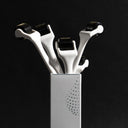Hair loss and baldness are common concerns that affect a significant portion of the population, particularly as individuals age. While hair thinning and shedding can occur at any stage of life, the onset of noticeable baldness tends to follow a general pattern. In this article, we will explore the typical age range when baldness starts and the factors that can influence its onset.
Table of content
At what age baldness starts?
The onset of baldness, or noticeable hair loss, can vary significantly from person to person, but it typically begins in adulthood. For most individuals, the first signs of baldness emerge between the ages of 20 and 40, with the majority experiencing some degree of hair thinning or balding by their mid-to-late 30s.
Understanding the Causes of Baldness
To better understand the age at which baldness starts, it's essential to recognize the primary causes of this condition. The most common type of baldness is androgenetic alopecia, also known as male pattern baldness or female pattern baldness.
Androgenetic alopecia is a hereditary condition that is influenced by hormones and genetics. It is characterized by a progressive thinning and loss of hair on the scalp, typically following a distinct pattern. In men, it often manifests as a receding hairline and thinning at the crown, while women tend to experience a more diffuse thinning across the entire scalp.
Age Range for Baldness Onset
While the age of baldness onset can vary widely, here is a general overview of the typical age ranges when hair loss becomes noticeable:
- Late Teens/Early 20s: While relatively rare, some individuals may begin to experience noticeable hair thinning or baldness as early as their late teens or early 20s.
- Mid-20s to Mid-30s: This age range is considered the most common time for the onset of baldness, particularly for men with androgenetic alopecia. Many individuals start noticing a receding hairline or thinning at the crown during this period.
- Late 30s to Mid-40s: For those who experience later onset of baldness, noticeable hair loss may become more apparent in their late 30s or early-to-mid 40s.
- After 50: While less common, some individuals may not experience significant baldness until after the age of 50, particularly in cases of female pattern baldness.
Factors Influencing the Age of Baldness Onset
The age at which baldness starts can be influenced by several factors, including:
- Genetics: The genetic predisposition to androgenetic alopecia plays a significant role in determining the age of onset and the severity of hair loss.
- Hormonal Changes: Fluctuations in hormone levels, particularly during puberty, pregnancy, and menopause, can trigger or accelerate hair loss.
- Stress and Lifestyle Factors: High levels of stress, poor nutrition, and certain medical conditions can contribute to premature or accelerated baldness.
- Environmental Factors: Exposure to certain chemicals, pollutants, or harsh hair treatments may also influence the age of baldness onset and progression.
Early Intervention and Management
While baldness is a natural process for many individuals, early intervention and proactive management can help slow down its progression and potentially prevent further hair loss. Some effective strategies include:
- Medications: FDA-approved medications like finasteride and minoxidil can help reduce the effects of hormones that contribute to hair loss and promote hair growth.
- Hair Transplantation: Surgical procedures like follicular unit extraction (FUE) or follicular unit transplantation (FUT) can restore hair in balding areas.
- Lifestyle Changes: Maintaining a healthy diet, managing stress levels, and avoiding harsh hair treatments can support overall hair health.
- Regular Monitoring: Regularly monitoring hair density and consulting a dermatologist or hair loss specialist can help identify and address baldness early on.
While the age of baldness onset can vary greatly, understanding the typical age ranges and contributing factors can help individuals take proactive steps to manage and potentially slow down the progression of hair loss.
Stop Hair Loss and Regain Confidence
Are you one of the millions experiencing hair thinning? You're not alone. Hair loss is a common concern, but it can significantly impact your confidence.
Bio-Pilixin Serum is a clinically tested and drug-free approach to combat thinning hair. Our unique formula, with plant growth factors derived from stem cell technology, nourishes hair follicles and promotes new hair growth.
See results in as little as 45 days and experience the benefits of Bio-Pilixin Serum:
- Reduce hair thinning and encourage new hair growth
- Improve scalp health and blood flow to the hair follicles
- Feel more confident with thicker, fuller hair
Don't wait any longer. Take control of your hair loss journey and regain your confidence with Bio-Pilixin Serum.
Read more:
- Dermatologist's Guide To The Best Derma Roller For Hair Growth
- 11 Best Shampoos For Thinning Hair Due To Menopause & Itchy Scalp
- 19 Best & Proven Shampoos For Hair Thinning In 2024
As your leading source for hair health information over the past 4 years, we never compromise on accuracy. When it comes to your health, you deserve information you can truly rely on - and earning your trust is our top priority.
Here's how Scandinavian Biolabs ensures every piece of content meets the highest standards of accuracy and integrity:
- Credentialed Experts: Our reviewers are actively practicing doctors and medical researchers
- Stringent Reviews: Content undergoes rigorous editing by subject specialists and review by a practicing doctor.
- Evidence-Based: We rely on well-established research from trusted scientific sources like peer-reviewed journals and health authorities.
- Full Transparency: Our editorial standards, writer credentials, reviewer credentials, correction process, and funding are all publicly documented.
- Independent Voice: While we do promote products, we operate in a vacuum to business operations. Our main goal is just an unwavering commitment to providing medically-sound guidance.
You can count on Scandinavian Biolabs to consistently deliver the trustworthy health information you deserve. Read our Editorial Standards.






